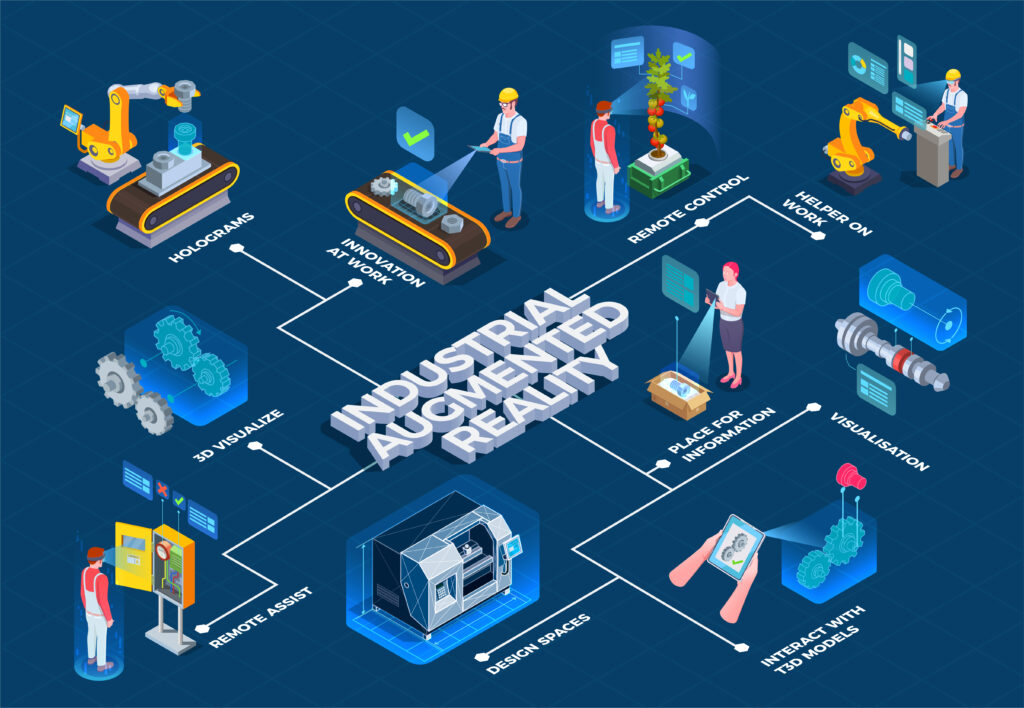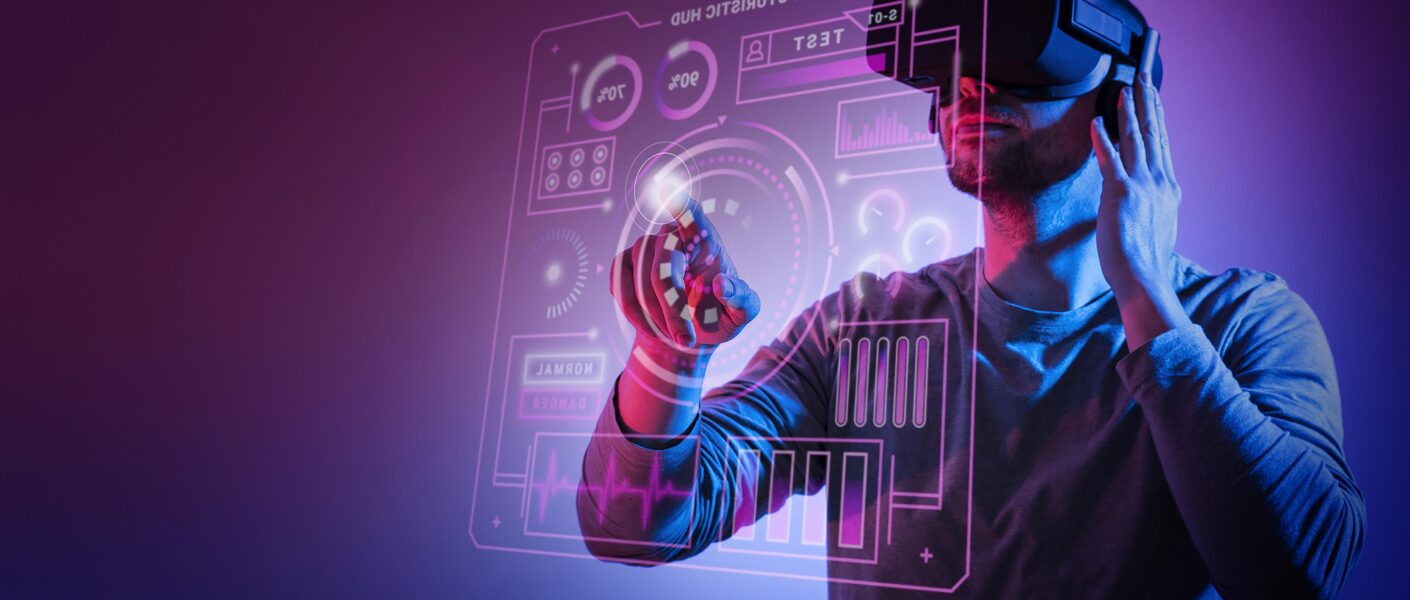Augmented Reality (AR) technology is changing the way we interact with the world around us. With the help of AR, we can overlay digital information on top of our physical environment, creating an immersive and interactive experience that blurs the line between the real and the virtual.
The potential of AR goes far beyond just gaming and entertainment. In fact, many industries are already using AR technology to enhance their operations and improve their bottom line.
But AR is not just limited to industrial and healthcare applications. It’s also being used to enhance the customer experience in retail and e-commerce. With AR, customers can see how products look in their own environment before making a purchase, reducing the likelihood of returns and increasing customer satisfaction. For example, IKEA has an AR app that allows customers to visualize how furniture will look in their homes before making a purchase, which has led to a 10-15% increase in online sales.
In the future, we can expect AR to become even more ubiquitous, with the technology being integrated into everyday products like glasses and car windshields. As AR technology continues to evolve, it has the potential to transform the way we live, work, and interact with the world around us.
Overall, the possibilities for AR technology are virtually limitless, and we can expect to see even more innovative applications of this technology in the coming years.
HOW AR TECHNOLOGY HELPING TOP 5 INDUSTRIES
AR technology has been adopted by many industries, including healthcare, education, retail, entertainment, and manufacturing. However, some industries have benefited more from AR technology than others. Here are some examples:
- Retail: The retail industry has been quick to adopt AR technology to enhance the customer experience. AR allows customers to virtually try on clothes, see how furniture will look in their home, or even visualize how makeup will look on their face. This technology has helped retailers to increase customer engagement and sales.
- Manufacturing: AR technology has also been adopted by the manufacturing industry to improve efficiency and reduce errors. AR can be used to overlay digital information onto real-world objects, providing workers with step-by-step instructions on how to assemble or repair equipment. This technology has helped to reduce production time and increase worker productivity.
- Education: AR technology has been used in education to create interactive and immersive learning experiences. AR can be used to provide visual aids that help students better understand complex concepts, or to create interactive educational games that make learning more engaging.
- Healthcare: AR technology has been used in healthcare to improve patient outcomes and increase efficiency. AR can be used to visualize medical data during surgery, provide virtual training for medical professionals, or help patients understand their medical conditions and treatment options.
- Entertainment: AR technology has been used to create immersive entertainment experiences, such as augmented reality games or interactive exhibits in museums.
Overall, AR technology has the potential to benefit a wide range of industries by enhancing the customer experience, improving efficiency, and creating new opportunities for innovation. As the technology continues to evolve, we can expect to see even more industries adopting AR technology to drive growth and improve outcomes.
AR TECHNOLOGY HELPING RETAIL INDUSTRY
AR technology has revolutionized the retail industry by providing new ways for customers to interact with products and services, both online and in-store. Here are some examples of how AR technology is helping the retail industry:
- Virtual try-on: AR technology has been used to create virtual try-on experiences for customers. For example, customers can use their mobile devices to try on clothing and see how it looks on them, without physically trying on the clothing. This technology has helped to reduce the number of returns and increase customer satisfaction.
- Product visualization: AR technology has been used to create 3D models of products that customers can view in real-time. For example, customers can use their mobile devices to see how furniture or home decor items will look in their home before making a purchase. This technology has helped to increase customer confidence in their purchases and reduce the number of returns.
- In-store experiences: AR technology has been used to create interactive experiences in physical stores. For example, retailers can use AR to create interactive displays that allow customers to explore products and learn more about them. This technology has helped to increase customer engagement and drive sales.
- Product information: AR technology has been used to provide customers with additional product information in real-time. For example, customers can use their mobile devices to scan a product and see additional details such as ingredients, manufacturing processes, and reviews. This technology has helped to increase customer confidence in their purchases and reduce the number of returns.
- Personalization: AR technology has been used to create personalized experiences for customers. For example, retailers can use AR to create virtual shopping assistants that provide personalized product recommendations based on the customer’s preferences and past purchases. This technology has helped to increase customer loyalty and drive repeat business.
AR TECHNOLOGY HELPING MANUFACTURING INDUSTRY
AR technology has transformed the manufacturing industry by providing new ways to optimize production processes, improve worker safety, and reduce errors. Here are some examples of how AR technology is helping the manufacturing industry:
- Assembly and maintenance: AR technology has been used to provide workers with real-time instructions and guidance during assembly and maintenance tasks. For example, workers can use AR glasses or headsets to view digital overlays of instructions and schematics, reducing the need for physical manuals and increasing accuracy.
- Quality control: AR technology has been used to improve quality control processes by providing real-time feedback on product quality. For example, workers can use AR technology to scan products and compare them to digital models, ensuring that they meet the required specifications.
- Training: AR technology has been used to provide workers with hands-on training in a safe and controlled environment. For example, workers can use AR technology to practice assembly and maintenance tasks without the risk of damaging equipment or products.
- Remote collaboration: AR technology has been used to facilitate remote collaboration between workers and experts. For example, workers can use AR glasses or headsets to connect with experts in real-time, allowing them to receive guidance and support without the need for travel.
- Design and prototyping: AR technology has been used to improve design and prototyping processes by providing real-time feedback on product design. For example, designers can use AR technology to view digital models of products in real-world environments, allowing them to test and refine designs before production.

With AR, workers can access digital information about machinery and products in real-time, which can help improve efficiency and reduce errors. For example, BMW has been using AR to train their technicians to repair engines, which has led to a significant reduction in training time and errors. Additionally, aerospace company Boeing has been using AR to improve the assembly process for their aircrafts, resulting in a 25% reduction in production time and a 90% reduction in errors.
AR TECHNOLOGY HELPING EDUCATION INDUSTRY
AR technology has transformed the education industry by providing new ways to engage students, improve learning outcomes, and create immersive learning experiences. Here are some examples of how AR technology is helping the education industry:
- Interactive learning: AR technology has been used to create interactive learning experiences that allow students to explore and interact with digital content. For example, students can use AR apps on their mobile devices to view 3D models of historical artifacts or scientific concepts, allowing them to understand complex ideas in a more immersive and engaging way.
- Virtual field trips: AR technology has been used to create virtual field trips that allow students to explore different places and environments without leaving the classroom. For example, students can use AR headsets to visit historical sites, natural landmarks, or cultural events, providing them with a more hands-on and engaging learning experience.
- Gamification: AR technology has been used to create educational games that motivate students to learn by making the process more fun and interactive. For example, students can use AR apps to play games that teach them math, science, or language skills, encouraging them to engage with the material in a more playful and enjoyable way.
- Simulations: AR technology has been used to create simulations that allow students to practice real-world skills and scenarios in a safe and controlled environment. For example, students can use AR technology to simulate medical procedures, engineering tasks, or emergency situations, providing them with hands-on experience that prepares them for real-world challenges.
- Accessibility: AR technology has been used to make education more accessible to students with disabilities or learning difficulties. For example, students with visual impairments can use AR technology to access digital content in a more meaningful way, while students with learning difficulties can use AR technology to receive personalized feedback and support.
AR TECHNOLOGY HELPING HEALTHCARE INDUSTRY
AR technology has been helping healthcare organizations in several ways, from improving the efficiency of medical procedures to enhancing patient outcomes. Here are some examples:
- Visualization of medical data: AR can help doctors and surgeons visualize medical data in real-time, which can aid in diagnosis and treatment. For example, AR technology can overlay MRI or CT scan images onto the patient’s body during surgery, allowing surgeons to accurately locate and remove tumors or other abnormalities.
- Surgical training: AR technology can be used to train medical professionals on complex surgical procedures. For example, AR can be used to simulate surgical procedures in a virtual environment, allowing medical professionals to practice and refine their skills without risking harm to patients.
- Patient education: AR technology can be used to educate patients about their medical conditions and treatment options. For example, AR can be used to visualize the effects of medications on the body or to show patients how to perform physical therapy exercises correctly.
- Rehabilitation: AR technology can also be used to aid in rehabilitation after injuries or surgeries. For example, AR can be used to provide visual feedback during physical therapy exercises, helping patients to perform exercises correctly and track their progress.
One example of AR technology being used in healthcare is the use of Microsoft’s HoloLens headset in medical education and training. Medical students at Case Western Reserve University in Cleveland, Ohio, are using the HoloLens to visualize and interact with human anatomy in 3D. The technology allows students to view and manipulate realistic holographic models of organs and other structures, enhancing their understanding of anatomy and improving their surgical skills.
The healthcare industry is using AR to help doctors and surgeons visualize complex medical procedures and improve patient outcomes. For example, surgeons at Johns Hopkins Hospital have been using AR to perform minimally invasive spinal surgeries, which has resulted in shorter hospital stays and faster recovery times for patients. Another example is the use of AR by the University of California, San Francisco (UCSF) to help patients with Parkinson’s disease overcome freezing of gait, a common symptom of the disease.

AR TECHNOLOGY HELPING ENTERTAINMENT INDUSTRY
AR technology has transformed the entertainment industry by providing new ways to create immersive and interactive experiences for audiences. Here are some examples of how AR technology is helping the entertainment industry:
- Augmented reality games: AR technology has been used to create popular games like Pokemon Go and Harry Potter: Wizards Unite. These games use the player’s mobile device camera to superimpose virtual characters and objects onto the real world, creating an immersive gaming experience.
- Live events: AR technology has been used to enhance live events such as concerts and sports games. For example, AR can be used to create virtual stage sets, allowing performers to create stunning visual effects without the need for physical props or sets.
- Interactive exhibits: AR technology has been used to create interactive exhibits in museums and art galleries. AR can be used to superimpose additional information onto exhibits, creating a more engaging and educational experience for visitors.
- Film and TV production: AR technology has been used in film and TV production to create realistic special effects and enhance the overall viewing experience. For example, AR can be used to superimpose digital images onto real-world environments, creating more realistic and immersive scenes.
- Virtual reality experiences: AR technology has been used to create virtual reality experiences, allowing users to immerse themselves in a completely digital environment. This technology has been used to create interactive exhibits, video games, and even virtual reality concerts.
Overall, the potential of AR technology is vast, and we are only scratching the surface of what is possible. As the technology continues to evolve and become more accessible, we can expect to see even more innovative applications in a wide range of industries, creating new opportunities for growth, productivity, and success. By embracing AR technology, organizations can stay ahead of the curve, differentiate themselves from the competition, and create new value for their customers and stakeholders.
MUST READ :
DIGITAL MARKETING- HOW IT OVERTAKING THE OTHER MEDIA


